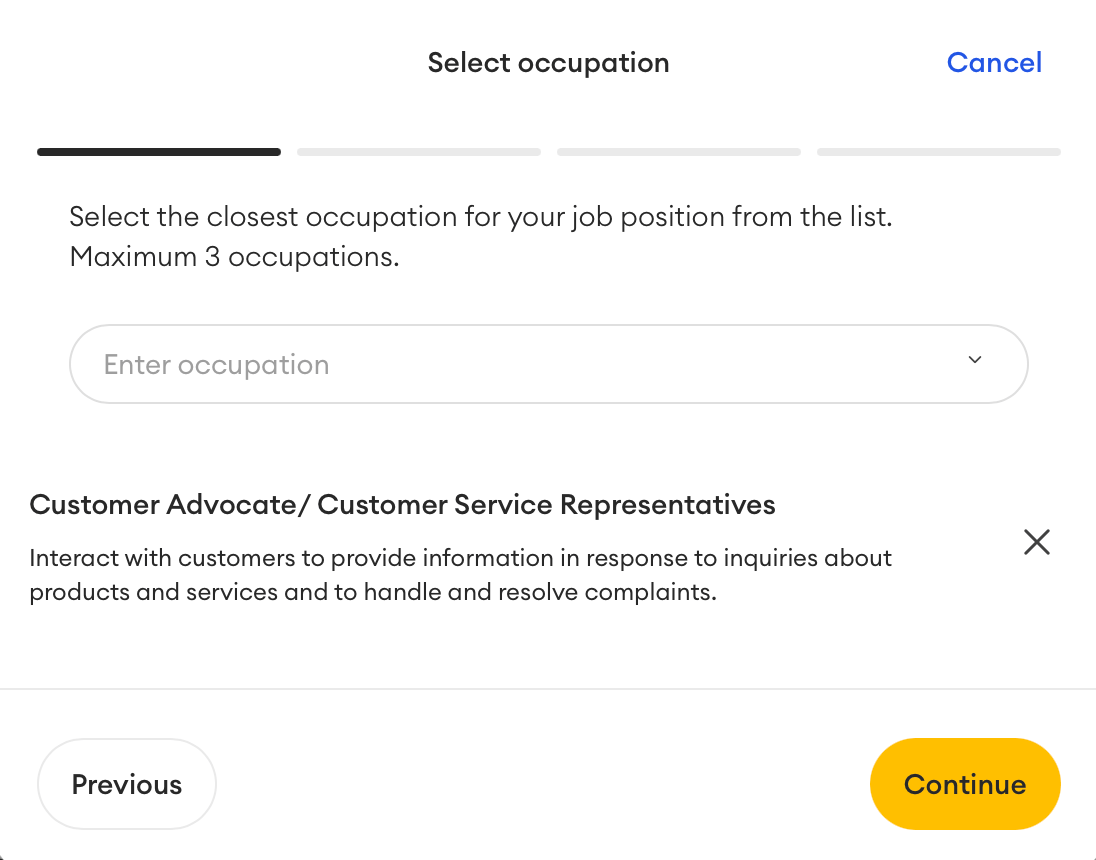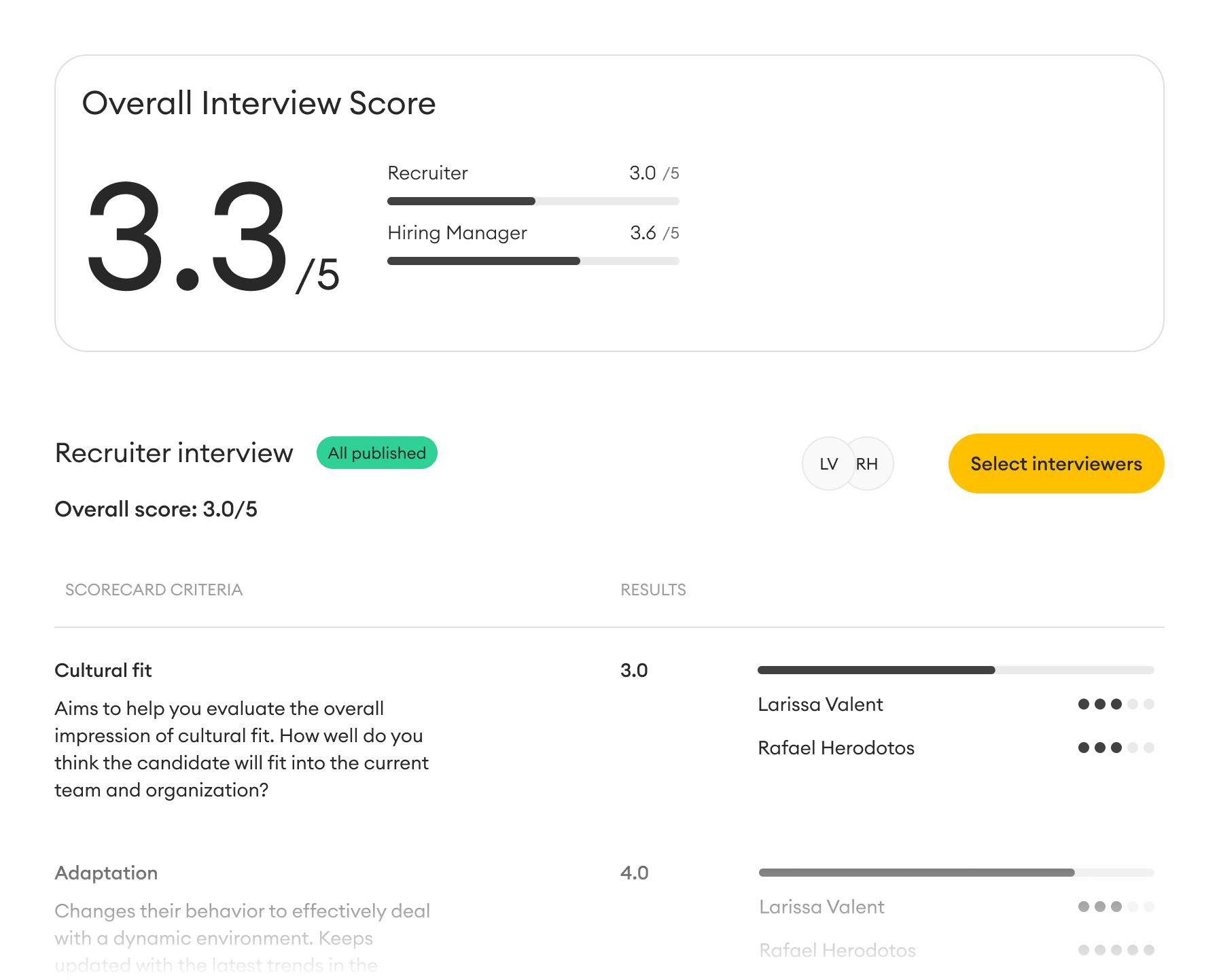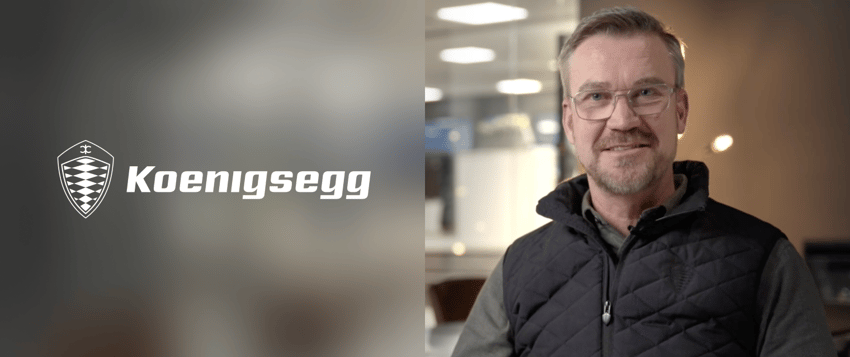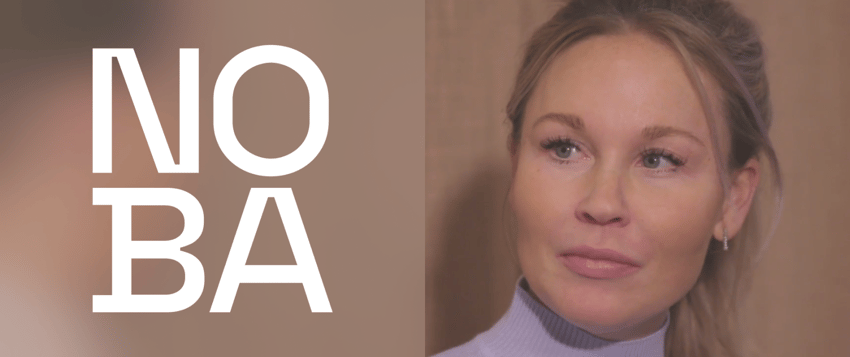The dynamic nature of the hiring landscape presents an ongoing challenge for Talent Acquisition professionals. It demands constant adaptation and alignment, particularly between Talent Acquisition and Hiring Managers. Misalignment can lead to inefficiencies, misunderstandings, and ultimately, the wrong hire.
On the other hand, a harmonised approach is a core aspect of operational excellence in Talent Management. It can add speed to the hiring process, improve candidate experience, and ensure you bring in the right competencies. In fact, studies show that organisations with a highly effective recruitment process have up to 3.5 times the revenue growth compared to their less effective competitors.
Contributing their insight and hands-on experience to this guide are our dedicated Customer Success Team members, Josh Spencer and Josefin Ekholmer, as well as one of our experienced Talent Acquisition professionals, Lisa Sindsjö Grahn. Their expert knowledge forms the backbone of these proven strategies.
In this guide, we'll dive into the tactics and methods to foster a gold-standard collaboration between the TA function and Hiring Managers. To illustrate this point, let's imagine you're hiring a new Customer Success Manager. Together we'll navigate the stages of this hiring process and show how to apply these learnings into your organisation.
Job analysis: defining your needs
Job analysis is the crucial first step in the hiring process, where we outline the requirements and competencies necessary for the role. We recommend taking a systematic approach and putting the role under a microscope. Without a well-defined problem, finding a solution becomes a challenge. The time and effort invested in a comprehensive job analysis provides benefits in multiple ways: it clarifies expectations, streamlines the process, and promotes alignment between Talent Acquisition and Hiring Managers.
For the hypothetical CSM, you'd want to sit down with the hiring manager and create a clear definition of the competencies for doing the job well, both hard and soft skills. Together, you can then determine the best way to assess these competencies. This includes establishing minimum requirements and identifying markers of high performance within the role.
If you determine, for instance, that relationship-building, presentation skills, and emotional intelligence are musts for this role, then you can align on when those should be best assessed in the hiring process. Does that evaluation take place in an interview, or a work-sample presentation?
Additionally, consider the level of work experience required. For a 20-person Customer Success team, we might not necessarily need previous CS experience. Instead, we might aim to expand the talent pool by welcoming candidates with experience in any customer-facing role.
"Ask Hiring Managers if it's a minimum or core requirement that (candidates) have done that exact thing in the past," says Alva Labs’ CSM Josh Spencer. "What are the skills we're talking about that are a little bit behind that? Because if you do that in a tight labour market, you can open up and be able to consider so many other people."
Consider these additional questions during the job analysis:
- 🎓 How much capacity do we have to support this person in onboarding and training them for the role?
- 📚 Do we have dedicated learning & development resources to support this person's growth in the CS team?
- 💼 How big of a customer portfolio will this CSM manage in the role?
- 💰 How much ARR (annual recurring revenue) will that consist of?
- 🤔 How complex are the problems that this CSM will be solving?
- ✅ Is industry/domain experience a must-have or a nice-to-have?
Following an in-depth conversation, the TA and Hiring Manager have reached a consensus. The ideal candidate should be commercially minded and proficient in building relationships. They should also be a strong communicator, both verbally and written, and demonstrate a high degree of emotional intelligence. With this clear candidate profile established, we can now proceed to constructing the hiring process.
Mapping the hiring process: defining your methods and flow
Mapping out the hiring process is a crucial step that goes beyond devising a sequence of stages leading to a hire. This stage is all about operationalising the insights gained from the job analysis to design an efficient, fair, and thorough assessment of potential candidates. This is where the rubber meets the road in the hiring process, converting your understanding of the role and its requirements into a concrete plan of action.
Josh points out, "If you're not doing a thorough mapping, then you're going to be defining the hiring processes as you enter them, which is not ideal." To avoid this scenario, you need to ensure that the mapping process is detailed and deliberate.
Here are the key areas you should focus on:
1. Define Minimum Requirements: Outline a 3-5 point questionnaire that serves as a first-level screening tool, allowing for efficient sorting of candidates who meet these basic criteria.
- ➡️ Example: You live in Stockholm and can commute three days a week to the office
➡️ You possess a valid driver’s licence
➡️ You have fluency in English, both written and verbal
2. Identifying Assessment Criteria: Decide on the core skills, competencies, and experiences to evaluate candidates. This should reflect the results of the job analysis.
3. Determining Assessment Methods and Stages: Decide on the method and stage of the hiring process where each competency will be assessed. This could be during an interview, a work-sample presentation, etc.
4. Crafting Assessment Questions: Develop specific questions or tasks that will be used to assess each identified competency during the hiring process.
5. Establishing Scoring Guidelines: Define clear scoring guidelines for each part of the process. These guidelines will help ensure objective evaluation of candidates and consistency across interviews.
6. Approval of the Hiring Process: Get approval from the Hiring Manager on the mapped hiring process. This step ensures alignment between the Talent Acquisition professional and the Hiring Manager.
Remember, there's no universal blueprint for hiring. The process can vary widely, ranging from a simple two-step procedure to a complex process involving numerous stakeholders for leadership candidates.
"Make sure to have an intent in every step of the process, and only run as many as you need to assess the candidate properly and efficiently," says CSM Josefin Ekholmer. “Being transparent with the candidate about the steps and what will be assessed is a great way to improve your candidate experience.”
Regardless of the role or required competencies, the constant factor is the structured assessment of a candidate's potential and readiness. During this mapping, we want to determine where we'll assess these competencies as well as the order.

In this hiring scenario, our TA and Hiring Manager have decided to use candidate assessments early on. This approach helps identify high-potential talent and enhances the predictive validity of the hiring process. They've chosen the Alva “Customer Service" test profile, aligning on the level of complexity. This assessment screens for traits such as Emotional Stability, Extraversion, and Structure, all o which can be captured via the Personality Test. Moreover, they've settled on scoring guidelines to determine which candidates advance in the process.
Interviews also play a critical role in this process. The TA and Hiring Manager have agreed on two structured interviews: an initial TA screening interview and a Hiring Manager interview. These will be followed by a short case presentation.
Each step of this process aims to delve deeper into whether the candidates have the necessary competencies for the role. The mapping ends with a discussion on the role each will play in this process, so there is no ambiguity on who is responsible. This last point is especially important for candidate experience, so that no candidate is left in the dark about whether they've moved forward in the process.
"Being thorough here (with your mapping) helps teams be as efficient as possible," says Josefin. "It’s also important to set clear expectations on the Hiring Manager, making sure they are aware of the time commitment and the responsibility they will have throughout the process."
Both of our hypothetical stakeholders are now aligned on the hiring process for the CSM role and can move forward to create the job ad.
Writing/publishing the job ad: open up your process
Setting up a robust and diverse pipeline of candidates is key to a successful hiring process. However, in order to do this, you must first attract the right people to your open roles. This is where the art of creating an effective job ad comes into play. A compelling job ad does more than just list the responsibilities of the role; it tells a story about your company, resonates with your ideal candidates, and gives them a clear vision of the purpose they'll serve.
Misalignment within the Hiring Team often arises during the job ad creation process. For instance, a Hiring Manager might insist on stringent role requirements such as a specific degree, formal qualifications, or a certain amount of relevant experience. However, these factors often don't correlate with job success and can be biased and discriminatory against specific candidates
Thanks to the close collaboration between our TA and Hiring Manager during the job analysis, they have a unified understanding of both the essential and desirable competencies for this role.
"All of those indicators of success or a high-profile candidate are what you should be packaging in the job ad," says Josh.
It's important to note that candidates are not just looking for a job - they're looking for a culture they can connect with, a role that gives them purpose, and a company where they feel they belong.
A compelling job ad goes beyond listing the basic requirements of the role; it paints a vivid picture of your company, the role, and the unique opportunity it presents. For more tips on writing job ads that convert, be sure to read our guide featuring tech recruiting expert Elisabeth Wehlin.
Screening for potential: making early funnel decisions
Once live and distributed, the job ad for the CSM role begins to attract candidates. Each applicant is automatically invited to complete a Logic Test and a Personality Test. Thanks to the alignment of our hiring team on the scoring criteria, the TA can seamlessly advance candidates to the next stage - the initial screening interview. This step determines who will embark on the core journey of the hiring process
Alva Labs’ Talent Acquisition Manager, Lisa Sindsjö Grahn, offers her insights on conducting screening interviews: "The screening interview is all about verifying the essentials. I focus on questions that address the 'must-haves' or the key requirements of the role. For instance, 'Can you share your experience working in a customer-facing capacity?'"
This stage aims to ensure that the candidate meets the basic criteria, setting the stage for a more in-depth evaluation in later rounds.
Before conducting a screening interview, our TA identified what they wanted to ask during those conversations.
Ideally, you structure the interview so that each candidate gets asked the same set of questions. Some questions here can be as simple as yes or no, such as "do you have experience working with customers?" And if one of the candidates were to answer yes, a logical follow-up could be: "can you provide a recent example of when you worked with customers?"
The goal of a screening interview is not to go deep with your questions. Rather, the TA should aim to check if the candidate has experience with the required competencies. There are also requisite hiring hygiene factors the TA should inquire about. It's common for TAs to ask about the candidate's notice period at their current job, what sort of salary expectations they might have, and if they're in other recruitment processes.
"In theory, we wouldn't make any adjustments from the earlier plan with the Hiring Manager," says Lisa. "But if this particular candidate is the most promising one after the screening interview, and has three other offers coming up, then we might need to adjust and book additional steps as soon as possible."
Assessing for readiness: the power of structured interviews
With the initial screening complete, a shortlist of eight candidates emerges. This is where the Hiring Manager steps into the spotlight. She'll conduct the next set of interviews aimed at further clarifying each candidate's suitability for the role.
Interviews are a fundamental element of the hiring process, universally embraced by both candidates and recruiters. The results wield significant influence over selection decisions. However, an unstructured interview process can introduce problems: subjectivity, susceptibility to Halo or Horns Effect bias, and is an overall obstacle to identifying the best fit for the role.
Implementing a structured interview process doesn't require a massive shift in an organisation's hiring philosophy. In fact, adhering to the Pareto Principle, the simple act of posing identical questions to all candidates can substantially boost the predictive power of interviews. This minor adjustment can yield major dividends in the search for the ideal candidate.
To support the Hiring Manager, the TA has set up an Interview Template in Alva. Both have reviewed the role requirements and identified a set of Situation-Behaviour-Result (SBR) questions, which are designed to give the candidate a stage to demonstrate their competency. Here's an example:
- Situation: Describe a situation where a customer was experiencing a complex problem that you couldn't resolve on your own.
- Behaviour: How did you involve other teams or colleagues to help solve the issue?
- Result: What was the result, and how did this experience influence your approach to teamwork and collaboration in the future?
During the interviews, the Hiring Manager can write their notes directly in the Interview Scorecard and then score them immediately afterwards.

Another part of the TA's role at this stage is preparing the candidates to set them up for success. By familiarising candidates with the SBR format, you give them a clear understanding of what to expect. This not only reduces their anxiety but also allows them to perform better in the interview, leading to more accurate and insightful responses. It's a practise that contributes to a more transparent and enriching candidate experience, facilitating better decision-making on both ends.
This structured interview process builds a solid foundation for both the candidates and the hiring team, a point that Josefin emphasises.
"Preparation is key," she says. "Setting a good foundation will ease your work so much and it will also help you make a final decision that is based on the combined data collected throughout the process."
If you want a deeper dive into how to run great interviews, be sure not to miss our comprehensive guide.
Hiring decisions: making your offer
After a round of interviews and a short case presentation, our TA and Hiring Manager find themselves with three compelling final candidates with the highest combined score. They've used a scorecard to help them consolidate scores from the structured interviews, the case presentation, and results from the Logic and Personality Test. The hiring team now convenes one more time to take the final decision. Although the combined score will help them to make a decision, the candidates' similarly high overall scores give the team the latitude to consider other, more subjective aspects to reach their final choice.
"At the end of the day, it's going to be a human decision," Josh says.
After closing on their preferred candidate, both the TA and the Hiring Manager perform a retrospective on the process, to see what could be improved for the next CS hire. And since the Customer Success team plans to open up another role within six months, the TA can simply reuse the Interview Template used in this process for added efficiency.
In the pursuit of the ideal hiring process, it's essential to recognise the power of structure and alignment. Striving for perfection is commendable, yet significant strides can be made by simply incorporating more structure into your process and diligently tying every step back to the initial job analysis. This consistency not only enhances the efficiency of your hiring operations but also provides a comprehensive and fair assessment of every potential candidate.
"You want to get these steps in your hiring process where you clearly have competencies tied to them, and where there's intention to every aspect," Josh says, "That's a huge win for your process overall."







